BLOG
4 Types of Market Segmentation: Real-World Examples & Benefits
Published: Dec 6, 2022
Market segmentation is the foundation of any successful long-term marketing strategy.
To get maximum value from your marketing budget, get to the heart of your customers’ shopping motivations by splitting your market into subgroups – then you’ll be in a stronger position to serve your customers’ unique needs.
According to research from SALESmanago, 77% of marketing ROI comes from segmented, targeted and triggered campaigns. So, if your marketing campaigns are falling flat, do more market research to understand what makes your customers tick across each segment.
One of the reasons market segmentation techniques drive more revenue for your business is because they can help you deliver personalized customer experiences. That’s why the best personalization tools let you segment your audience so you can:
- Drive more email and SMS leads
- Lift website conversion rates
- Improve average order values
- Increase customer lifetime value
In this blog, I’ll walk you through the four main types of market segmentation:
And I’ll also cover:
- Transactional segmentation
- Technographic segmentation
- Generational and life stage segmentation
- Firmographic Segmentation
- 8 benefits of market segmentation
What is market segmentation?
Market segmentation is a technique you can use to divide your customer base into subgroups based on shared characteristics, such as age, income, hobbies and location. The aim of segmentation is to tailor marketing efforts to your ideal customer profile (ICP), i.e. the customers most likely to buy your product or service.
For example, a customer at an organic food shop is likely to have some or all of these characteristics:
- Gender: Male or Female
- Age: 25-44
- Income: $100,000+
- Life stage: Home owner, no children
- Interests: Healthy eating, sustainability, sport
Rather than wasting your budget on campaigns that target a broad section of the market, use messaging that resonates with a market segment made up of customers with those attributes. You should also consider which channels are likely to drive the highest engagement.
For this hypothetical organic food shop, a Pinterest campaign marketing products with sustainable ingredients would be a strategic way to appeal to potential customers. Why Pinterest and not another social channel? Well, not only do 9 out of 10 Pinners browse the social media platform for purchase inspiration, it’s also used by up to 80% of Millennial women and 40% of Millennial men.
Why is a market segmentation strategy important?
According to Bain and Company, businesses that tailor strategies to customer segments generate yearly profit growth of 15% vs 5% for businesses that don’t. In short, market segmentation can drive significant growth.
Segmentation techniques are major profit drivers because they help you define your target market and qualify customers as users of your product or service. You can then provide the personalization that 73% of shoppers now expect from brands – sending the right message, through the right channel, at the right time.
Market segmentation also helps you to:
- Enter new markets
- Build products that solve customer pain points
- Streamline sales processes
- Drive more revenue from email marketing
- Drive more revenue from social media marketing
- Increase eCommerce customer retention
4 Key market segmentation types & examples

1. Demographic segmentation: The who
Widely used by D2C ecommerce brands, demographic segmentation is one of the most simple yet effective kinds of segmentation. You can use demographic segmentation to split your audience and create customer personas based on objective information, such as:
- Age
- Gender
- Income
- Level of education
- Religion
- Profession/role in a company
For example, if you segment your audience based on your customers’ income, you can target them with products that fall within the constraints of their budget. If you’re a small business or new to ecommerce, this is a straightforward type of segmentation with three key advantages:
- It’s easy to collect information
- It’s simple to measure & analyze
- It’s cost-effective
Luxury goods manufacturer Montblanc worked with Yieldify to present a selection of offers across their website. They lifted conversions by 118% with a Father’s Day deal offering a free gift to customers spending over £200 – a threshold that took the spending expectations of Montblanc’s target audience into account.
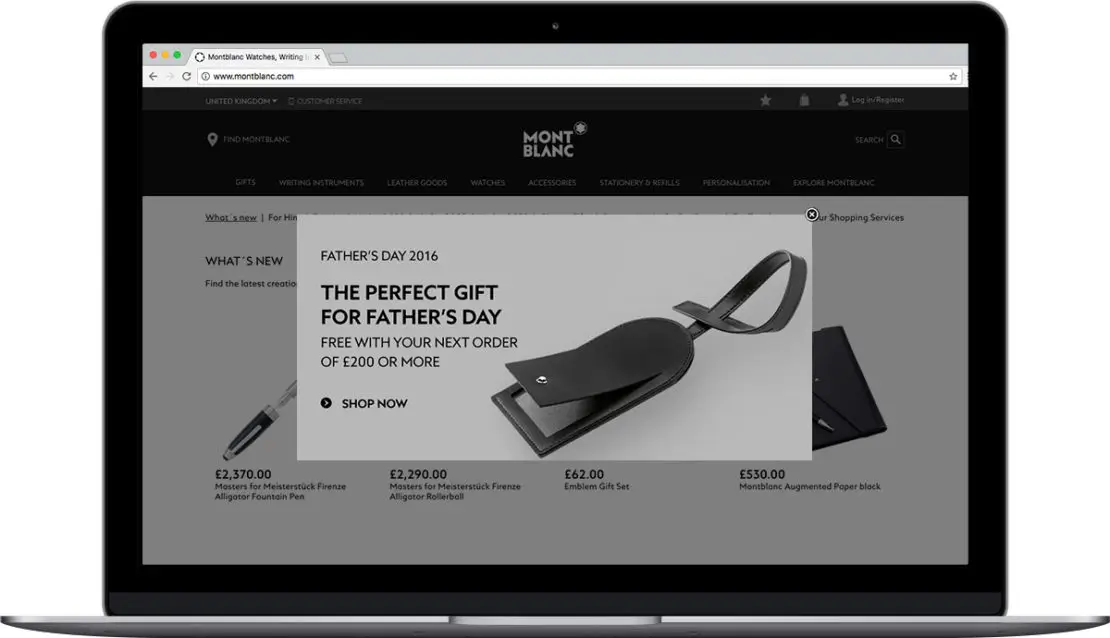
2. Psychographic segmentation: The why
Psychographic segmentation is the process of grouping people together based on similar personal values, political opinions, aspirations and psychological characteristics.
For example, you can group customers according to their:
- Personality
- Hobbies
- Social status
- Opinions
- Life goals
- Values and beliefs
- Lifestyle
Because these characteristics are subjective, psychographic is a harder segment to identify – but it’s also the most valuable. The best places to gather data for psychographic segmentation are through your audience analytic tools and social media, but you should also use surveys, interviews and focus groups to strengthen your customer understanding in this segment.
Through psychographic segmentation, you can get a deep insight into your customers’ likes, dislikes, needs, wants and loves. You can then create marketing campaigns that resonate with their psychographic profile.
Yieldify’s personalization technology helps you create on-site experiences that capture more psychographic information about your customers. For example, Heidi, a leading online travel agency, collected information about their customers’ preferred skiing style with layered lead capture experiences.
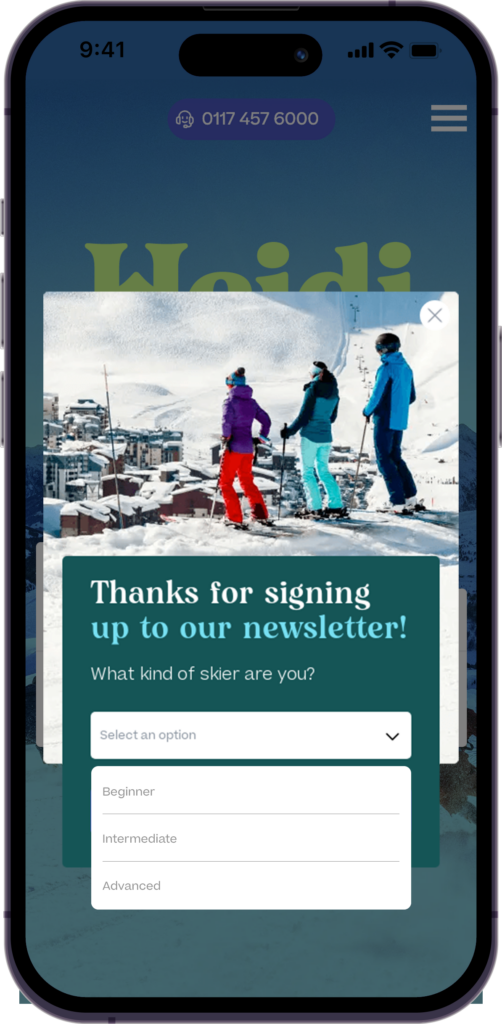
3. Geographic segmentation: The where
Geographic segmentation is the process of grouping customers based on where they live and where they shop. People who live in the same city, state or zip code typically have similar needs, mindsets and cultural preferences.
The real advantage of geographic segmentation is it provides an insight into what your customers’ location says about a number of geo-specific variables, such as their:
- Climate
- Culture
- Language
- Population density – (urban vs rural)
As with all market segmentation methods, you’ll need to analyze your data to understand how each factor influences your customers’ shopping behavior. For example, people living in colder climates are likely to be in the market for winter clothing and home heating appliances.
You can also use geographic segmentation to solve practical problems. With Yieldify, global fashion brand Nautica used geo-targeting to show different customers when they could guarantee Christmas delivery. Customers in rural areas had to order earlier than urban areas, so Nautica’s delivery countdown timers adapted according to the customer’s location.
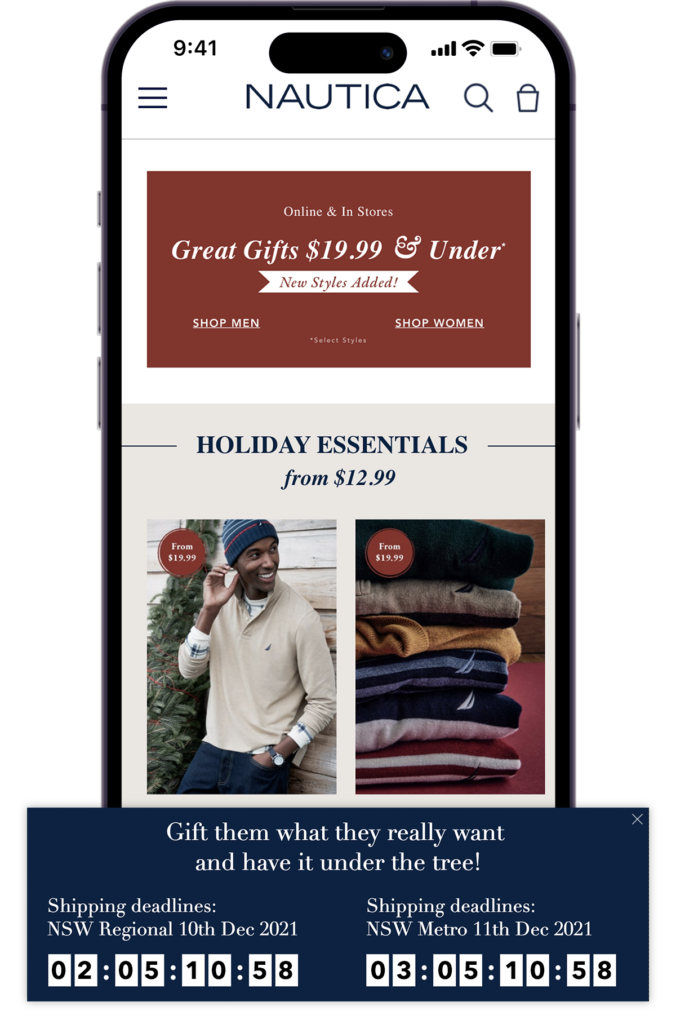
4. Behavioral segmentation: The how
Behavioral segmentation is the process of grouping customers based on common behaviors they exhibit when they interact with your brand.
For this type of segmentation, you can group your audience based on their:
- Spending habits
- Purchasing habits
- Browsing habits
- Interactions with your brand
- Loyalty to your brand
- Product feedback
Gather this objective data through your website analytics and you can identify patterns in your customers’ behavior that help predict how they’ll interact with your brand in the future.
Then you can leverage this hypothesis to provide personalized recommendations that address your customers needs. For example, Spotify provides its users with curated daily mixes based on the types of genres and artists they’ve listened to previously.
At Yieldify, we use behavioral segmentation to deliver highly relevant and targeted campaigns based on behaviors including:
- Number of sessions to your website
- Number of pages visited
- Time spent on site
- URLs visited
- Page types visited
- Exit intent
- Inactivity
- Shopping cart value
- Campaign history
- Referral source
For example, Petal & Pup tailor their email lead generation messaging for visitors arriving from Facebook.
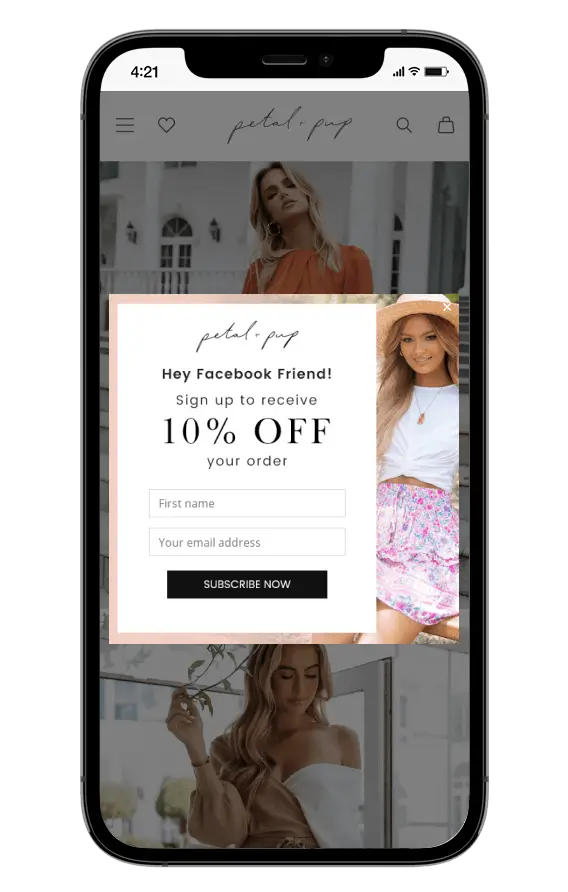
Other types of market segmentation with examples
Demographic, psychographic, geographic, and behavioral are the four pillars of market segmentation, but consider using these four extra types to enhance your marketing efforts.
Technographic segmentation
Technographic segmentation groups people based on the technology they use and how they interact with it. For example, you could segment early adopters of new tech and target them when you launch a new product to market.
Alternatively, you could present customers with deals depending on what device they use to shop online. For example, you could show Apple products to consumers who use Safari.
Generational and life stage segmentation
Generational segmentation expands on demographic segmentation by grouping customers based on their generation – Boomers, Gen Z, Millennials, etc.
You can also segment customers by factors including marital status, home ownership and number of children.
For example, Bank of America successfully incorporated life stage segmentation in their digital marketing strategy. They invited customers using their Family Life Banking program to specify their life stage circumstances when they signed up. From there, they directed customers to a microsite designed specifically for that segment.
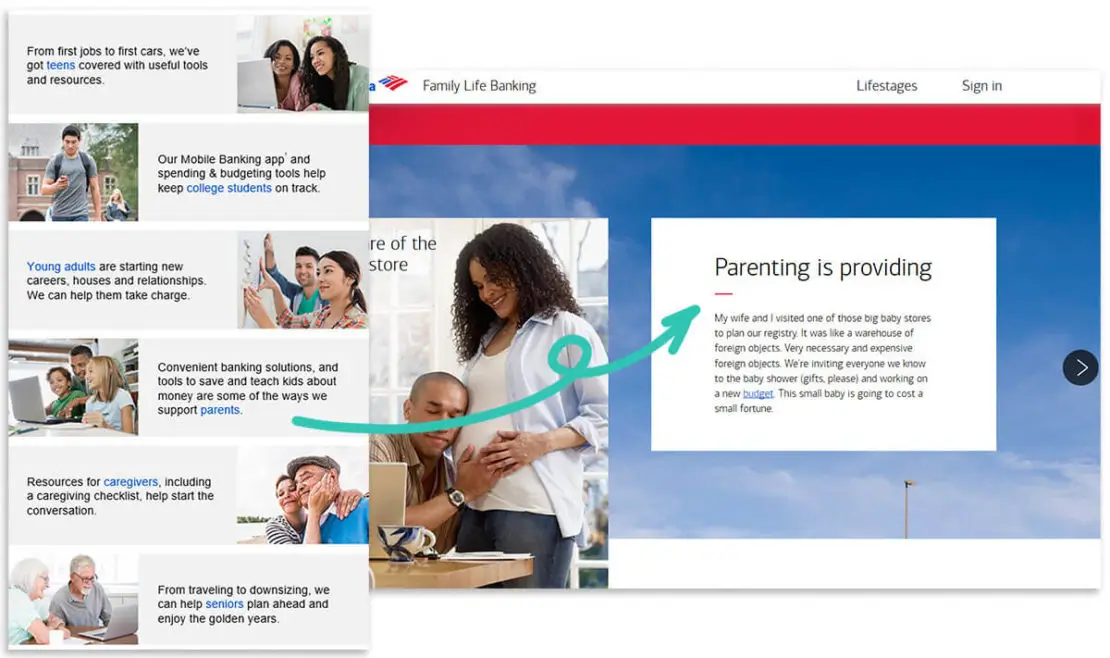
Transactional segmentation
Using transactional segmentation you can group customers based on their previous purchase interactions with your brand, including:
- Source of brand discovery – e.g. social media, organic
- Date of most recent order
- Total number of transactions
- Average order value
Firmographic Segmentation
Most of the market segments I’ve discussed focus on D2C brands, but firmographic segmentation is a tool B2B companies use to create more impactful marketing campaigns.
Firmographic segmentation is the process of analyzing and classifying B2B customers based on shared company characteristics, and is similar to how D2C marketers use demographic segmentation.
Use these 7 factors to create firmographic customer segments:
- Industry
- Location
- Company size
- Status
- Number of employees
- Performance
- Executive title
- Sales cycle stage
8 Benefits of Market Segmentation
1. Better ROI from marketing
According to research from SALESmanago, 77% of marketing ROI comes from segmented, targeted and triggered campaigns.
2. Set your omnichannel strategy
The deep insights you glean from a strong market segmentation process will help you set an omnichannel strategy that better addresses your customers’ needs. For example, if a high percentage of your customers are from Gen Z, tailor your messaging across all channels to speak to their cultural and social reference points.
3. Build customer loyalty
Market segmentation helps you build the personalized journeys your customers are craving. According to Accenture, 79% of consumers are more loyal to brands that use personalization tactics.
4. Reach new markets
Segmentation helps brands identify gaps in the market. For example, world-renowned camera company Canon took a 40% share in the low-end digital camera market by spotting an opportunity to sell cameras to children without smartphones.
5. Reduce customer acquisition costs
The insights you glean from creating segmented customer personas will make your marketing campaigns more effective. That can be said for both D2C and B2B brands.For example, insurance giant Metlife set annual savings targets of $800 million after streamlining its sales process to consider the behaviors and attitudes of each customer segment.
6. Build better products
With a clearer understanding of who your customers are, you can create products that better serve their needs, desires and expectations.
7. Higher quality email & SMS leads
You’re more likely to get leads into your email and SMS databases by adapting your opt-in form according to customer segments. With Yieldify, American footwear company Rockport drove 30% more revenue per lead using a segmented approach to lead capture.
8. Drive more revenue from email marketing
Marketers have increased open rates by 14.3% and revenue by up to 760% using segmented email campaigns.
Build your own market segmentation strategy
I hope this blog has given you a clear understanding of how you can use market segmentation tactics to optimize your market strategy. If you want more information about how you can leverage market segmentation on your ecommerce website, check out this page on Yieldify’s audience segmentation capabilities.
Market Segmentation FAQs
Market segmentation is the process of dividing the market into subsets of customers who share common characteristics. The four pillars of segmentation marketers use to define their ideal customer profile (ICP) are demographic, psychographic, geographic and behavioral.
The four main types of market segmentation are:
1. Demographic
2. Psychographic
3. Geographic
4. Behavioral
Market segmentation helps you qualify customers of your product or service and serve them with more personalized marketing campaigns that speak to their unique needs. A good market segmentation strategy will help you:
– Drive more marketing ROI
– Reach new markers
– Cut customer acquisition costs
– Build better products
– Increase brand loyalty